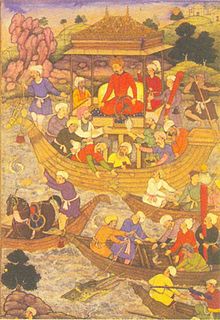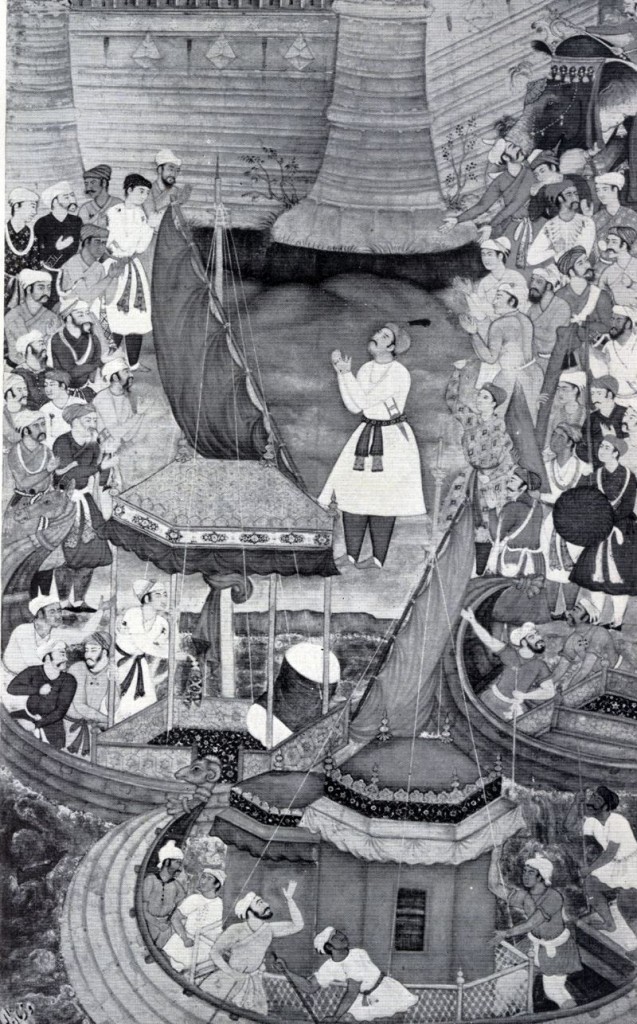SHIP BUILDING IN LAHORE
EMPEROR AKBAR AT HIS BEST
Amazing industry of Lahore

No one will think of Lahore as a ship building city, not ever reckon that the bank of the river had a LAHORI BANDAR, yes a shipyard in Lahore. Amazing to even think of same these days. And the kind of shipyard by the same name was in SIND too (the Lahori ships went there and travelogues of Englishmen dictate such travels), which was also called a Lahori bandar, and there are manuscripts of those times with the name on it. Why was it so? For the river RAVI was not the impotent river of today but a gushing river of plenty of water. Under the Indus Water Treaty India robbed Lahore of its river Ravi. Ravi now shows itself in flood only and it was the flood in 1952, when it drowned portions of Lahore in it. The same had happened annually in times of Aurangzeb and that is why he built the AURANGZEBI BUND in Lahore, w

hich existed for a long time, before the Sikhs and the British stole its bricks away.
Some years back they were digging the foundations for a house on Mohni road, and they came across the relic of an old lost ship. Again nobody bothered. The wood was no good for modern use, not was there any gold attached. Rusted iron and withered wood, that was it. Nothing good for the treasure hunters of today. This was the way of the trail of the old river Ravi. We in Lahore used to call it Buddha darya (old river), and relics were there for a long time.
Emperor Akbar ruled Lahore for 18 years, 14 years as the Capital of Hindustan itself. This 14 years rule was from 1584 to 1598, and here we have a recorded incident dated May, 1594. Historians have written that:
“A ship was completed on the banks of the Ravi. The length of the keel, which formed the foundation of this wooden house, was 35 Ilahi yards, 2936 large planks (shahtir) of sal and pine, and 468 maunds and two seers of iron, were used in building it, and 240 carpenters and blacksmiths and others were employed. His Majesty went to see the spectacle.”
It must have indeed been a spectacle, for it was so big, that to drag it to water, a thousand persons were called in to help. There was indeed not enough water at that time to make the transition easy. But it was done. A proud feat for the Mughal Industry.
In the ‘Maseray-Raheemi’ of Abdur Raheem Khan e Khanaan, we are told that this Royal Courtier also had a ship built, to enable selected citizens to perform free Haj every year. The prospective Hajis used to avail the facility. Shah Shuja was also fond of ships and had ships stationed in Surat, the later ship yard of the British. Aurangzeb also used to ride ships. He was seen in a ship in Benaras itself. But the big event was the inauguration of the Badshahi Mosque Lahore, when Aurangzeb came in a ship to inaugurate it. An incident happened at that time, when from the bank, a mad man threw a brick at him. The man was caught but the Emperor had him set free. That was the justice of those incredible rulers.
In any case very little gets written about Lahore, and it is our job as citizens of Lahore to tell it to the world. The achievements of Lahore always worthy of praise by all.
Historians write of this and we need to revisit information and see it as:

Emperor Akbar, who ruled much of India in the latter half of the 16th century, apparently had a great interest in modern shipbuilding. This might have been sparked in part by his relations with the Portuguese (who had established themselves at Goa by this time) and their modern warships. It is known from the Akbarnama and Ain-e-Akbari that several large, ocean-going ships were built in India under Akbar’s reign, at Lahore and Ilahabas (Allahabad). The first such ship was built in June 1592 near Lahore; construction could not place near the coastline itself due to a lack of timber. The ship was built of 3000 large wooden planks and roughly 12 tons of iron was used, with a keel measuring close to 100 feet in length. This would make it on par with the galleons being built in Europe at the same time. The constructed ships were transported by massive barges to the Mughal ports in Sindh, where they were put to sail in the Arabian Sea.
Unfortunately, Akbar’s successors did not share his enthusiasm in shipbuilding, and a modern ocean-going Mughal navy comparable to those of European powers never materialized. But what if the successors of Akbar had invested more resources in the development of a navy? How would it affect the commercial and political interactions between India and the European powers in the 17th and 18th centuries?

Surprising isn’t it
.
So the Mughals were well into ship building. And it was happening in Lahore, means the tech they has was pretty reliable and indigenous. What made them abandoning the development at that time ? ……. any possible reasons ? This must be a real dilemma for the historian.
.
The Englishmen had come here along with other foreigners. They could be the factor behind the abandoning of the struggle
The Portuguese are what happened. The Spanish Armada was the fright of the oceans in that time, so when Portuguese came to India, they quickly gained control of all our major ports, signing treaties with the Mughals that they’d protect their waters – since they now owned them – so India didn’t need to build her own navy. Indian fishermen had to apply for licenses from the Portuguese just so we could ply our own waters. It was partly for this reason that the Mughals favored the East India Company and the British, as the British navy has always been the world’s best navy and by allowing them to trade with us, we were able to play them off against the Ports and beat them off our ports lol. The lighter and smaller English galleys had to fight and beat the great Portuguese ones to get here and earn the emperor’s favor.
I wish some references had been given for the facts stated in the article.
This is meant for general reading. Not for scholars. But certainly for researchers such things can be shared with time. Obviously we had to read a lot to get to the crux of it.